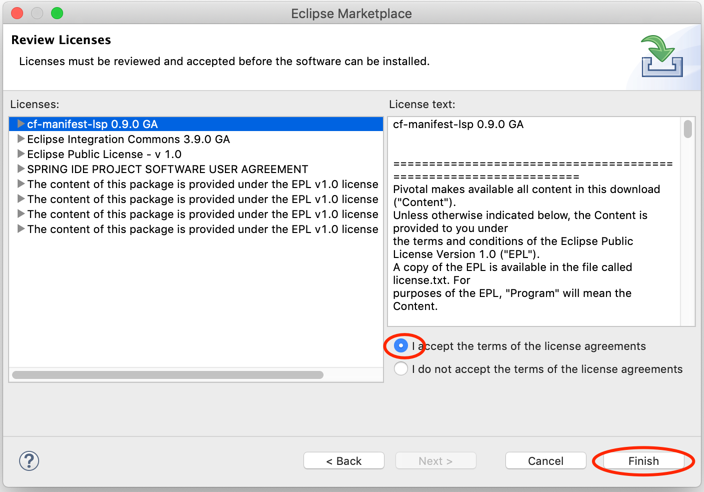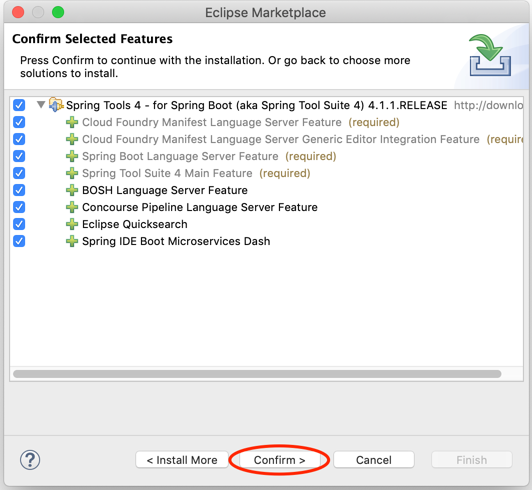Thank you for downloading Spring Tool Suite para Mac from our software portal. The software is periodically scanned by our antivirus system. We also encourage you to check the files with your own antivirus before launching the installation. The package you are about to download is authentic and was not repacked or modified in any way by us. In SpringSource Tool Suite, click Window Preferences from the menu. In the Preferences window, click Java Compiler in the left panel. In the right panel, set the Compiler compliance level to 1.6. Click Apply.You will get a message asking if you want a full rebuild; click Yes.The rebuild should take very little time to complete. Find more information about version 3 of the Spring Tool Suite on the Spring Tool Suite 3 wiki including downloads, update site URLs, references to the new and noteworthy pages, and details of how to upgrade to Spring Tools 4. VMware offers training and certification to turbo-charge your progress. STS-Tool, the modelling and analysis support tool for STS-ml, is freely available for download for multiple operative systems. To download the latest STS-Tool version, select the version that suits you, and complete the small form that will appear below the selection.
This tutorial will show you how to build a simple web app using Spring Framework and STS (Spring Tool Suite). It’s a beginner guide and it will help you if you are new to Spring or STS.
NOTE: This tutorial requires Spring STS to be installed and configured with Eclipse IDE. If you haven’t done this step yet please read Install Spring STS in Eclipse first.
What is Spring Boot
This tutorial uses Spring Boot to create a simple web-app with running on embedded Tomcat server.
Spring Boot is Spring’s solution for creating stand-alone applications that are easy to build and run. It uses preconfigured Spring platform and third-party libraries so you can get started within minutes. Most Spring Boot applications need very little Spring configuration. This particular example does not need any configuration at all.

Features of Spring Boot:
- Create stand-alone Spring applications
- Embed Tomcat or Jetty directly (no need to deploy WAR files)
- Provide POM file to simplify your Maven configuration
- Automatically configure Spring whenever possible
- Provide production-ready features such as metrics, health checks and externalized configuration
- Absolutely no code generation and no requirement for XML configuration

Create New Spring Starter Project
1. Start Eclipse and go to File -> New -> Other… or press Ctrl+N on your keyboard
In the search field type “spring”. This will list several Spring options. The one we need for this tutorial is “Spring Starter Project”. Select it and confirm with “Next” button
2. Use the setting shown in the screenshot below.
Choose a name for your project. Select Maven as build tool, JAR packaging and your Java version.
Under Package type the package name. Artifact is the name of the JAR file you are going to build. For example if you use springexample as artifact the final JAR file will be called springexample.jar
Spring starter project settings
3. In “New Spring Starter Project Dependencies” window select Web.
If you can’t find it in the list, use the search field and type into it “web”
Confirm with “Finish” button. STS will create the project for you and download all needed dependencies.
4. Once the project is created you will see one main Java class called SpringBootExampleApplication.java, one Java class for testing purposes, empty properties file, a Maven POM file and 2 files to execute the application from command line. In the screenshot below you will see on the left the project structure and the content of the main class on the right.
Spring Boot web-project structure
Run Your Spring Boot Application
Right-click your project, go to “Run As” and select “Spring Boot App”

This will bootstrap the embedded Tomcat server, deploy your app and map the URLs. In Eclipse console you will see an output similar to this one:
Once the application is started, open your browser and navigate to http://localhost:8080

You will see a page labeled “Whitelabel Error Page”. This is totally fine. Don’t worry. It indicates that the server is started, but there is no mapping available for URL “/”. We will fix this in the next step.

Spring whitelabel error page
Create a Request Mapping
Now, to be able to see some “meaningful” content under http://localhost:8080 we need to change the code of SpringBootExampleApplication.java a bid. First annotate the class with @Controller annotation. Second create a request mapping to URL “/” – this will map the home() method to this URL. In other words when the browser makes a GET request to http://localhost:8080 it will be served by this method. Finally to be able to return a response to the browser you need to annotate the home() method with @ResponseBody. You will find all the changes below:
Relaunch the Spring Boot App
Before you can see the changes you just did in the previous step you need to redeploy you changed app. To achieve this use the “Spring relaunch button” shown on the screenshot below
Now go to your browser and refresh the page. You should see the string our home() method returns on the screen
Program output
Spring Tools Suite
Complete source code of the project can be found in our GitHub repo under: https://github.com/JavaTutorialNetwork/Tutorials/tree/master/SpringBootExample
Related Tutorials
Spring Tool Suite Free Download
- Install Spring STS in Eclipse
This guide shows you how to install Spring Tool Suite in Eclipse STS stands for Spring Tool Suite. It provides ready-to-use environment to implement, run,…
- Java Servlet Example
In this tutorial I will show you how to create Servlets and deploy them in Apache Tomcat 8 What are Servlets? Servlets are the building…
- Java JSP Example
This example demonstrates how to create a simple JSP page In my previous tutorials I have shown you how to use Servlets to handle requests,…
